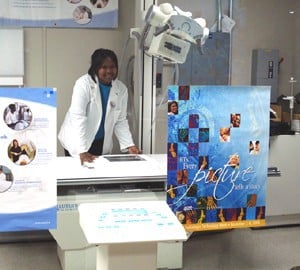Radiologist Assistants Boost Clinic Efficiency
| Nov. 8, 2010 | “I love it,” said Melody Runkel when asked how she likes working as a radiologist assistant. After working 17 years as a radiologic technologist, Runkel went back to school at the University of Arkansas for Medical Sciences (UAMS) and earned her master’s degree to work in the new radiologist assistant profession. As a radiologist assistant (RA) at UAMS affiliate Arkansas Children’s Hospital, she conducts more advanced imaging procedures on patients – conducting swallowing studies or fluoroscopic exams such as an upper gastrointestinal (upper GI) or barium enema. She performs interventional radiology tasks such as lumbar punctures and placement of catheter lines. All of the work is done under the direct supervision of a staff radiologist, but she has more autonomy than a technologist, and there is a higher level of skills required. “I love my job because it’s more hands-on work with patients, so I feel like I can play a larger role in their care,” Runkel said. “I know my work benefits patients and that our physicians are very supportive.” Scott Lile, M.D., an assistant professor in the Department of Radiology of the UAMS College of Medicine, said having a radiologist assistant improves efficiency. The RA can perform many of the routine examinations, freeing up the radiologists to see more patients and the clinic to schedule more appointments. “Having a radiologist assistant allows us to get more examinations done in a day,” Lile said. Charles James, M.D., a professor of radiology in the College of Medicine and medical director of the radiology service at Arkansas Children’s Hospital, said the RAs will be in increasing demand once administrators can be shown the value of having one on the radiology department staff. Radiologist assistants are one of the many allied health professions that make up the modern health care team. Nov. 7-13 is Allied Health Professions Week, recognizing their contributions to patient care. And those contributions are in ever-greater demand. With the growth of the elderly population, demand for health care is expected to continue increasing. People aged 65 and older represented 12.4 percent of the nation’s population in the year 2000 but are expected to grow to be 19 percent of the population (about 72 million people) by 2030. “We’re already seeing shortages of physicians and I suspect it will get worse before it gets better, so there is going to be a high demand for people who can assist health care providers,” said Ronald Winters, Ph.D., dean of the UAMS College of Health Related Professions (CHRP). Radiologist assistants and nuclear medicine advanced associates are like physician assistants or nurse practitioners as a class of professional known as a physician extender. They can conduct more advanced procedures and carry more clinical responsibilities under the supervision of a physician. “Radiologists want them,” said Rebecca Ludwig, Ph.D., chairman of the CHRP Department of Department of Imaging and Radiation Sciences, about the imaging sciences physician extenders. “We’re now getting applications from providers where program graduates are working, which to me illustrates the value these health care providers see in radiologist assistants and nuclear medicine advanced associates.” The varied allied health professions are critical to the present and future of health care, representing roughly half of those professionals working in health care today. “For every physician working today, there are two pharmacists, four nurses and eight allied health professionals,” Winters said, adding that allied health professions make up some of the fastest growing professions in the U.S. “Arkansas is greatly undersupplied in several professions and in many geographic areas of the state.”
|

